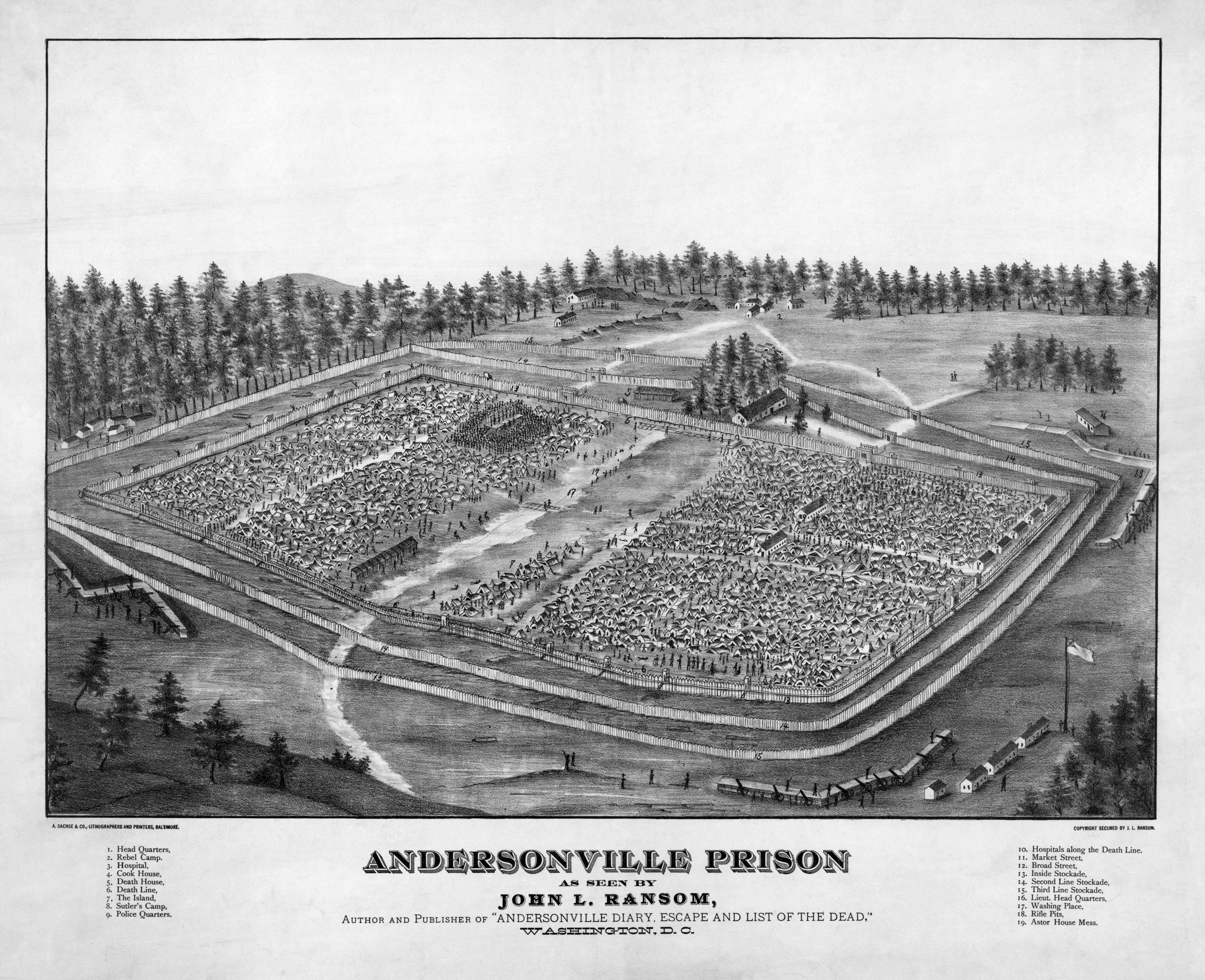
Near the end of the Civil War many stories ran through out the Union army of the horrors of a prison camp in south Georgia known as Andersonville. Many union soldiers felt that it would be better to die than to be sent to that dreaded place.
In November of 1863, Confederate Captain Sidney Winder was sent to the village of Andersonville in Sumter County, Georgia, to evaluate the potential of building a prison for captured Union soldiers. The southern location, the availability of fresh water, and its closeness to the Southwestern Railroad, made Andersonville a good prison location.
In January of 1864, slaves from local farms were used to cut trees and dig ditches for construction of the prison. The prison enclosure was approximately 1010 feet long and 780 feet wide. The walls of the stockade were constructed of pine logs cut on site, hewn square, and set vertically in a wall trench dug roughly five feet deep. The poles were hewn to a thickness of eight to 12 inches and “matched so well on the inner line of the palisades as to give no glimpse of the outside. A inner fence known as the deadline was built approximately 20 feet inside the stockade wall to distinguish a no-man’s land keeping the prisoners away from the stockade wall. Anyone crossing this line was shot by sentries posted around the stockade wall.
Prisoners began arriving at the prison in February of 1864 and by June the prison population had climbed to over 20,000. It was decided that a larger prison was needed and by mid-June work had begun to enlarge the prison. The prison’s walls were extended 600 feet to the north surrounding an area of roughly 10 acres bringing the total prison area to 26.5 acres. The extension was built by a crew of Union prisoners in about 14 days. On July 1, the northern extension was opened to the prisoners who subsequently tore down the original north stockade wall then used the timbers for fuel and building materials. By August over 33,000 Union prisoners were held in the 26.5 acre prison that was designed to hold 10,000.

The stream of water that supplied the camp soon became polluted by human wastes and other pollutants. Diarrhea and dysentery spread throughout the camp. Deaths from those ailments, as well as from gangrene and other diseases, occurred by the scores. The greatest toll being 90 on August 23: 1864.
A group of Christian prisoners finally decided they would pray to God for pure water and would not stop until their prayers were answered. They prayed for hours. Finally a deafening noise like thunder or an earthquake shook the earth, and where they were kneeling a stream of water burst forth from the torn ground. They considered this phenomenon a providential act of God and so the stream of water was called Providence Spring.
One eyewitness account was handed down to his Grandson a certain Blake Myers. He said that his grandfather was one of those in the prayer group and that is the story he told him when he was a boy was true.
One of the historical accounts reported that the spring was originally there, but had been covered over when the camp construction work was in progress. Nevertheless, those who prayed for water believed God’s providential act provided an answer to their prayers.
Providence Spring has continued to flow all these years since 1864 and was flowing the day I saw it in July 2002. There are some that have gone to great lengths to remove the story of the miracle that took place that August day in 1864
One such testimony is from a Confederate soldier who was 15 at the time of the miracle. He said that there was no account of the miracle even though he admits that others gave testimony of it. Another testimony of the miracle was a Union soldier from Maryland who was there and was witness to the miracle was S.E. Lookingbill of Company C 6th Maryland Vol., Inf., 2nd Brigade 3 Division, 6th Army Corps, Army of the Potomac
There is a fine stone house erected in 1901, at Providence Spring and this Inscription is on the wall: “The Prisoners’ cry of thirst rang up to Heaven; God heard, and with His thunder cleft the earth and poured his sweet water came rushing here.” On another side of this house is the inscription: “God smote the hillside and gave them drink, August 16, 1864.
There has been a great deal written about Providence Spring and what caused the water to come out of the earth at this place. I will state that I was there at the time God gave this spring to us, and this spring came through prayer for water.
The water furnished the stockade by the branch became so unfit from the filth on the outside and from the cook house and stables that there was a general cry for water from all over the camp and God heard the cries of his people and gave them Providence Spring. The Confederates at the time, and even to this day, call this Providence Spring, and say that God answered the soldiers’ prayer for water.
Today, when one visits Andersonville the story of the miracle is mentioned but played down. How sad that our history is being changed or forgotten all in the name of academic freedom.





It is very sad that our history is being played with.